Elevator pitch
China experienced significant economic progress over the past few decades with an annual average GDP growth of approximately 10%. Population expansion has certainly been a contributing factor, but that is now changing as China rapidly ages. Rural migrants are set to play a key role in compensating for future labor shortages, but inequality is a major issue. Evidence shows that rural migrants have low-paying and undesirable jobs in urban labor markets, which points to inefficient labor allocation and discrimination that may continue to impede rural–urban migration.
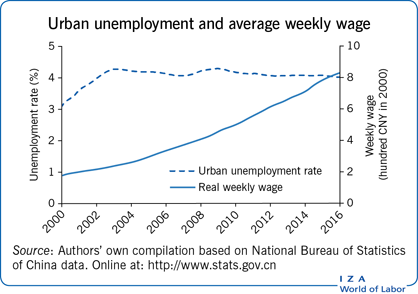
Key findings
Pros
Unemployment is at its lowest level in 20 years, implying that the Chinese economy is close to full employment.
The youth labor force is abundant in rural areas and should serve as an important factor in dealing with China’s aging population.
Real earnings for both rural migrants and urban residents increased over the last 20 years.
Cons
China’s population is aging rapidly, which will strain public finances.
Due to a low proportion of youth, the working-age population may decrease in the future.
Governmental policy divides rural and urban workers into two tiers in urban areas; rural migrants earn less, have higher unemployment rates, and are not eligible for many social benefits, which impedes rural–urban migration.
The labor force in China is more expensive than in many other developing countries, and numerous foreign firms have relocated their operations outside of China as a result.
Author's main message
China’s remarkable economic growth during the last three decades enabled the country to surpass Japan as the world’s second largest economy. One of the leading factors behind this growth has been its very large working-age population. However, as this population ages, a potentially insufficient labor force may threaten future economic growth. Rural youth may present the answer to this challenge, but the government must begin treating rural migrants equally by offering them full citizenship rights in urban areas. Further relaxation of fertility control will also be important to prevent future decreases in the youth labor force.
Motivation
China is now the world’s second largest economy, and it continues to grow at a phenomenal rate. China has gradually increased its impact on the global economy via international trade, and its steady progress has advanced global economic development. China’s rapid growth over the last three decades benefited from the so-called “demographic dividend,” referring to its large proportion of working-age people during this time, but that situation is now changing. This makes understanding the evolving features of the Chinese labor market a crucial task for the design of future policy agendas.
Discussion of pros and cons
Population, labor force, and urban unemployment
Before the mid 1990s, China was characterized by a centralized job assignment system. Essentially, all urban workers were hired into state-owned enterprises (SOEs) or collectively-owned enterprises (COEs), and firms were prohibited from dismissing workers. After experiencing huge profit losses, SOEs and COEs were substantially restructured from 1997 to 2000, which led to an increase in the number of dismissed urban workers at the turn of the century. The subsequent privatization of SOEs and the burgeoning non-state enterprises then enabled the private sector to begin absorbing surplus workers in urban labor markets. The reform period neared its end in 2006.
The unemployment rate in the urban labor market from 2000 to 2016 is presented in Figure 1. As seen, the rate increased from nearly 3% in 2000 to around 4.5% in 2004, which can be attributed to fallout from the major reforms. From 2004, the unemployment rate started to decrease. It increased at the outset of the global financial crisis in 2007, but stabilized at around 4% after 2010. The size of the labor force and the working-age population remained stable after the global financial crisis, as is also shown on the figure. The working-age population neared one billion, whereas the labor force was approximately 800 million in 2016. The figure also shows a picture of near full employment in recent years, though it should be noted that the official unemployment rate may be biased downward, especially during the reform period of the SOEs and COEs. This is because the National Bureau of Statistics of China (NBS) uses self-registered unemployment to calculate the country’s unemployment rate but many eligible workers did not register themselves as unemployed.
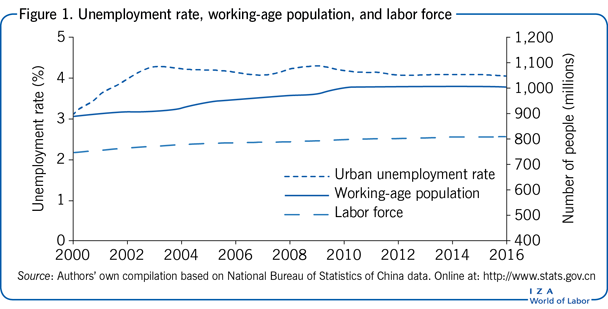
Figure 2 examines the population’s age structure in urban and rural areas in 2016. A striking feature is that the population below the age of 20 is considerably lower in urban areas. For example, the number of urban residents younger than 20 is about 120 million, compared with 476 million people in urban areas between the ages of 20 and 59. This means that the urban labor force is likely to increase rather slowly when today’s youth enter the labor market, and may even experience a significant drop in the future. In fact, labor shortages in urban areas are already evident in recent years. This issue is attributed to a highly restrictive population control policy.
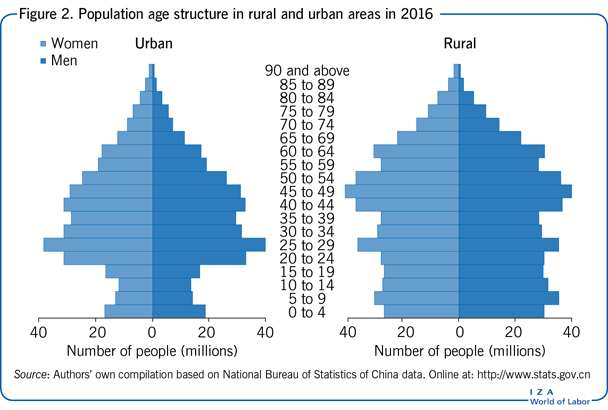
The so-called “one child policy” was implemented in 1979 and limited the number of children couples could have. Specifically, urban couples were allowed to have only one child, whereas rural couples with one daughter could have a second child. Exceeding this quota incurred severe penalties. For example, urban residents could lose their jobs as well as their access to social welfare. The punishment for rural people was a one-time fine, which most could not afford. Not surprisingly, the policy significantly reduced fertility rates [1], [2], which will undoubtedly influence the future labor force, with one study claiming that the number of working-age people will peak early in 2015 and then begin to decrease [3]. Indeed, according to the 2015 census, the fraction of people between the ages of 15 and 59 decreased by 2.8% compared to 2000. The UN predicted in 2015 that China’s total population will peak in 2030 with 1.416 billion people and then begin to decrease to 1.348 billion in 2050. In light of these potential problems, the one child policy was gradually relaxed by the government [4]. In 2014, couples, of whom at least one was an only child, were allowed to have a second child, and in 2016, the one child policy was formally replaced by a universal two child policy. However, these changes do not seem to be significantly influencing birth rates, and China continues to face the very real prospect of population decline.
Rural migrants
A key aspect to consider when looking toward the future is China’s rural population. As shown in Figure 2, the proportion of the population in rural areas below the age of 20 is comparable with those between 20 and 60 years of age in rural areas, as can be seen from the similar number of people in the five-year interval between the two age groups. Therefore, absorbing rural workers into urban areas can help address the expected decrease in cities’ labor supply. However, for decades, rural migrants have been discouraged (and in many cases prohibited) from residing in cities because of a government system called hukou. Established in the 1950s, this system categorizes individuals as agricultural or non-agricultural (hukou) people based on their place of birth, and is intended to anchor peasants to the countryside. In 1992, as economic growth accelerated, the central government relaxed restrictions on migrant mobility in order to meet increasing labor demand in cities. At first, a large number of rural people moved into urban areas to find jobs. However, rural migrants were treated very differently from urban residents, causing the situation to change in recent years.
As a consequence of the hukou system, the growth in the number of migrant workers from rural areas has stagnated in recent years, with many factories in the industrial coastal areas facing a shortage of migrants in 2009. According to the China Statistical Yearbooks Database (CSYD), the number of migrant workers began to decrease further after 2011. The main reason is that despite being allowed to live in cities, rural migrants still face substantial obstacles, and continue to be treated as outsiders. Specifically, urban hukou residents hold higher-ranking jobs, earn higher wages, and enjoy more government subsidies compared with rural migrants. Urban workers are also granted additional social benefits, such as housing, education, and other non-wage advantages. The urban labor market is referred to as a two-tier market, which will be discussed in detail in the next section. Thus, most of these migrants opt to work in urban areas only temporarily, and then return to their home counties after earning some money.
Demographic change
China’s aging population is becoming a massive problem that extends beyond the issue of labor shortages. A large increase in the proportion of those above the age of 70 is expected by 2030. According to the UN, China is aging more rapidly than almost any country in recent years [4]. The baby boom in the 1960s and 1970s and the subsequent one child policy distorted the country’s population structure. In the 1960s and 1970s, the total fertility rate for a woman was about six (by contrast, it was only 1.28 in 2014). When the baby boomers grew up and entered the labor market, the working-age population increased considerably. China’s economic growth thus benefited from this so-called “demographic dividend” over the past three decades or so, but the environment is changing as those baby boomers age. Figure 3 presents the dependency ratio of children and the elderly from 2000 to 2016. This ratio, defined as the number of dependents per 100 working people, compares the difference between those not in the labor force with those who are working. The figure shows that the dependency ratio of retired people rose from 10% in 2000 to 15% in 2016. Meanwhile, the number of children has been stable at a historically low level since 2010. This indicates that the aging population is a major concern in the future, because expenditures on social security and medical programs will be high.
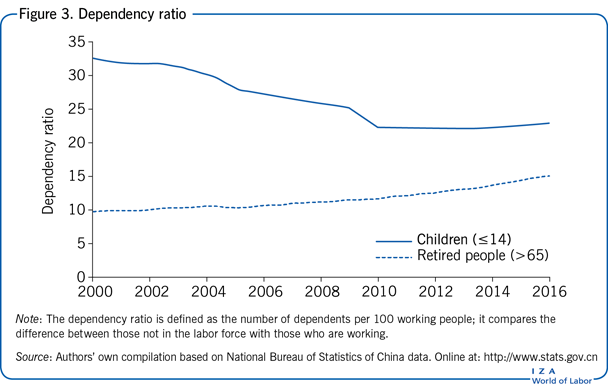
Hukou and the evolution of the two-tier urban labor market
China essentially had no labor market before the 1980s. Instead, a central planning system was established by the Chinese government, which allowed it to control the prices of food, goods, services, employment, and wages. The government monopolized the purchase of agricultural products and assigned quotas to urban people who could purchase products at low prices [5], and labor mobility from rural to urban areas was restricted by the central government.
In the late 1970s, economic reforms began in China, as the planning system had become incompatible with economic development. As a consequence, China started welcoming foreign investment for the first time, and the potential increase in competition compelled SOEs and COEs to improve their efficiency and performance, with SOEs adopting wage reforms and decentralized labor management. In 1984, the government changed the fixed-wage system, in which wages were set by the government, to a floating-wage system, in which SOEs and COEs were allowed to set their own wages. At that time, the unemployment rate in China did not exceed 1%.
Non-state-controlled firms began to emerge, and entrepreneurs were allowed to run businesses in urban areas. These developments, along with other reforms, made labor allocation highly flexible in urban labor markets.
With this rapid growth of non-state sectors, the demand for rural labor dramatically increased, and peasants were enthusiastic about moving to urban areas. This led to a gradual relaxation of the restrictions on labor mobility so that peasants who acquired jobs in urban enterprises or who owned businesses were allowed to migrate temporarily to cities but did not receive food support from the state. However, rural migrants were not welcomed by urban residents, and governments often forcibly relocated them to the countryside for security and other reasons.
Beginning in 1992, the economy was further opened up, thereby permanently changing China’s economic development path. To meet the growing labor shortage in urban areas, the government further relaxed its stance on migrant mobility. Instead of restricting rural peasants to their home counties, the government formally allowed rural laborers to migrate to cities as long as they could provide required certificates, including identification cards, temporary resident permits, and employment certificates [5]. This led to a substantial increase in rural—urban migration, with the number of rural migrants residing in urban areas reaching 50 million in the mid-1990s [6]. Local governments responded to the associated increase in competition for jobs by establishing policies to restrict the employment of rural migrants to specific occupations, thereby protecting urban workers. Most of these posts were classified as dirty, dangerous, and demeaning, or were occupations that urban people were unwilling to accept [7]. Despite these challenges, this marked a major societal change, as rural migrants were no longer being expelled from urban areas.
Since 1992, China’s economy has been developing at full speed. Average GDP growth increased by almost 10% per year from 1992 to 2016. Rural migrants provided much of the cheap labor force that promoted this high growth rate. However, the hukou policy persists, and rural migrants are still classified as outsiders, taking jobs with low wages and long working hours. They are also not able to enjoy many of the social benefits available to urban residents, such as health care, housing, and insurance, and their children are often prohibited from attending urban public schools.
Rural versus urban: Demographics and unemployment
There are considerable differences between the basic demographic characteristics of working-age urban residents and rural migrants. Figure 4 uses data from the China Health and Nutrition Survey (CHNS) to display some of these features over the period 2000–2011 in urban areas. In China, the retirement age is 60 for men and 55 for women. Hence, people older than 16 but younger than 60 (for men)—younger than 55 (for women)—are included in the figure. Compared with urban workers, a higher proportion of migrants are male, which may indicate that rural migrants usually undertake dirty and physically strenuous posts, such as construction work and as porters. Migrants are also younger than urban workers; the average age of rural migrants in 2011 was 40.6 years, compared to 41.8 for urban workers.
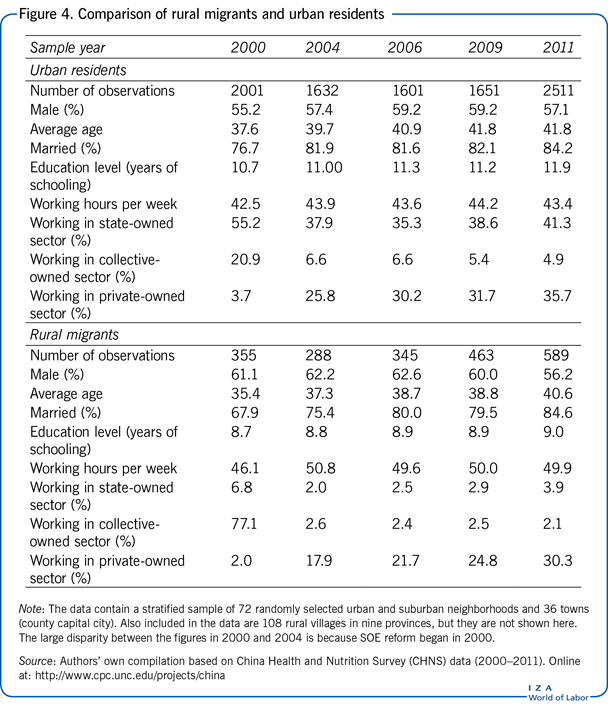
The difference in formal education between migrants and urban workers is large. Specifically, rural migrants completed just under nine years of education on average (equivalent to finishing middle school), which is the compulsory number of years of education in China. In comparison, urban workers had an average of 12 completed school years, the equivalent of high school. The large gap in education between rural and urban workers suggests lagging human capital development for rural workers [8]. In addition, rural migrants’ average weekly working hours are much longer than those of urban workers. The Labour Law of the People’s Republic of China, which went into effect in 1995, requires laborers to work no more than eight hours a day and not more than 44 hours a week, on average. Figure 4 shows that urban residents worked an average of nearly 43 hours per week. By contrast, rural migrants worked close to 50 hours per week, implying that many work paid overtime.
The main occupation sectors of migrant and urban workers are also shown in Figure 4. Since restructuring, the remaining SOEs include large firms with strong monopoly power that are active in primary industries designated as strategic by the government (including armaments, aviation, petroleum, electric power, telecommunication, and shipping). Figure 4 shows that the number of urban residents employed in SOEs was much higher than that of rural migrants. For example, more than 40% of urban workers were employed in SOEs in 2011, whereas only 4% of rural migrants worked in this sector. This suggests that migrants encountered difficulty in finding jobs in the primary sector, and that barriers restricting labor mobility across primary and secondary sectors still exist.
Figure 5 compares the unemployment rates for rural migrants and urban workers using CHNS data. The unemployment rate for both types of workers decreased from nearly 8% in 2000 to around 4–5% in 2011. For urban workers, the unemployment rate in 2000 was 7.4%, which can mainly be attributed to the restructuring of SOEs in the early 1990s. These figures differ from the official unemployment rate reported by the NBS, because the latter only counts those who register for unemployment assistance as being unemployed. The government allowed SOEs to dismiss surplus employees because of uncontrolled financial losses, which resulted in millions of workers being terminated. The layoffs of urban workers slowed after 2000, and the number of unemployed workers decreased from 7.4 million in 2000 to 6.0 million in 2004. The unemployment rate for rural migrants peaked in 2004 due to extensive dismissals from COEs between 2000 and 2004. The subsequent privatization of SOEs and COEs along with the simultaneous emergence of non-state enterprises caused the private sector to begin absorbing surplus workers in urban labor markets. Even so, the unemployment rate of rural migrants has always exceeded that of urban residents, implying that rural migrants still face more difficulties finding jobs.
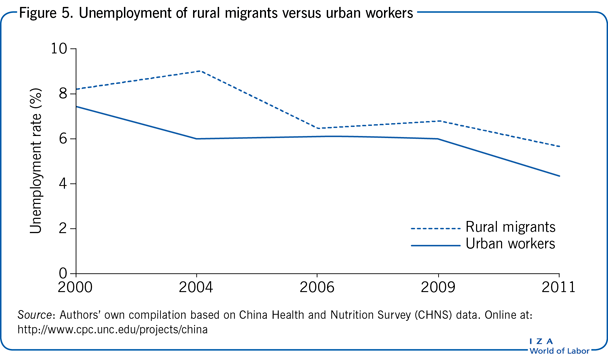
Further examining the CHNS data, it is interesting to compare the human capital of unemployed workers to see how this influences the difference in unemployment rates between rural migrants and urban citizens. To do this, a person’s unemployment status can be related to his/her education level, gender, marital status, and experience. The results show that one additional year of schooling would decrease the unemployment rate of urban residents by 1.4% and by 0.9% for rural migrants, implying that education offers greater rewards to urban residents. Furthermore, female urban workers are more likely to lose their jobs than male workers; however, gender does not matter for rural migrants in terms of the probability of losing one’s job. Being married is associated with lower unemployment rates for urban residents, but such an association is not found for rural migrants. Finally, work experience significantly lowers unemployment among both rural and urban workers. However, the effect of one more year of work experience was larger for urban workers than for rural migrants.
Wages
Figure 6 presents average real weekly wages for urban workers and rural migrants from 2008 to 2016 (the data are not available before 2008). Overall, wages trended upwards during the sample period. For example, the real weekly wage increased from 410 CYN in 2008 to 830 CYN in 2016 for urban workers and from 280 CYN to 560 CYN for rural migrants. Moreover, the wage differentials between urban workers and rural migrants widened in the sample period. In 2008, urban workers’ wages were approximately 46% higher than those of their migrant counterparts. By 2016, the gap had widened to 48%.
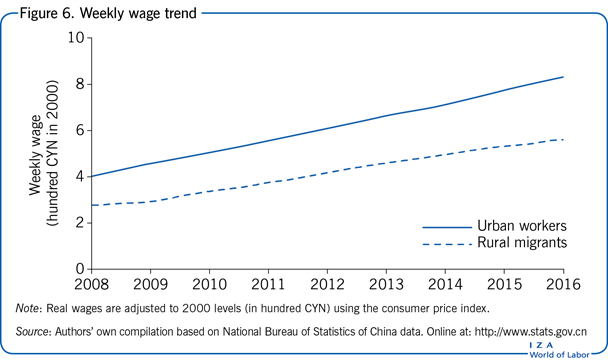
The migration of rural workers into cities once helped keep wages low in urban areas. However, the significant rise in wages over the past decade indicates that this is no longer the case. Evidence shows that Chinese labor was relatively cheap compared to its productivity before 1997 but since then it has become comparatively expensive [9]. Labor productivity rose by 11.3% per year from 1997 to 2010 compared with a wage growth of 13.8% per year in the same period. This has led to a situation in which labor in China is now more expensive than in many other developing countries. According to the ILO, the monthly earnings of an employee in China’s manufacturing sector was US$740 in 2015, compared with US$581 in Brazil, US$138 in Indonesia, US$312 in Thailand, and US$210 in Vietnam. Moreover, a new labor law has recently been enacted, which provides employers and employees the opportunity to settle salaries, working conditions, compensation, holidays, and other matters on the negotiating table. Hence, stagnating migration, the potential decline in labor supply due to demographic changes, and the new labor law could be driving factors for the earning disparity between China and other developing counties. As a result, many foreign firms have moved their factories to other Asian countries, such as Vietnam or Indonesia, which have lower wages and thus lower labor costs. Several domestic firms have also opted to establish new plants in inland areas instead of the traditional coastal areas.
Limitations and gaps
A major limitation when examining the Chinese labor market is that official data on rural migrants are unavailable for recent years. This makes it extremely difficult to compare unemployment rates between rural migrants and urban residents across most years. This article employs CHNS data, but that survey ended in 2011, so its value is limited. As such, it is not possible to compare unemployment rates between the two types of workers after 2011.
Given the findings in this article, there are a number of topics deserving further research. For example, work should be undertaken to identify feasible solutions for dealing with China’s significant demographic challenges. Specifically, the accelerated aging of the labor force and the slow increase in the number of young people are of critical importance.
Another topic that warrants further investigation is the trend of foreign firms moving their factories to other countries to avoid rising wages in China, and how this may impact future economic growth.
Summary and policy advice
China is set to face major challenges in the coming decades due to its rapidly aging population. The high dependency ratio of retirees and very low birth rates may significantly inhibit future economic growth, and are sure to strain public finances.
One of the key issues that may help to alleviate China’s demographic challenge is the situation of rural migrants in urban labor markets. The prominent hukou policy still separates workers into two distinct tiers, with most rural migrants occupying the bottom of the social strata in cities. In line with this, the evidence shows that substantial inequalities exist between rural migrants and urban workers, with the latter group earning higher wages and having lower unemployment rates than their migrant counterparts.
The Chinese government must provide abundant funding to care for its elderly in the future. The budget should thus be reevaluated to improve spending efficiency. One option is to promote the reallocation of workers from SOEs to private firms and to further relax financial constraints on private companies. Turning to the issue of a declining labor supply, increasing the fertility rate would help address the decreasing proportion of youth in the population. This calls for a possible further relaxation of population control policies. Furthermore, while the urban labor force is aging rapidly, an abundant supply of youth labor exists in rural areas. Hence, rural migrants could play an important role in dealing with the aging urban population challenge. Policymakers should therefore devote substantial attention to reducing segregation in urban labor markets, and rural migrants should be able to enjoy the same benefits as their urban counterparts.
Acknowledgments
The authors thank an anonymous referee and the IZA World of Labor editors for many helpful suggestions on earlier drafts. The authors are grateful for the funding support provided by the Ministry of Education of China (No. 16YJC790109), Guangdong Planning Office of Philosophy and Social Science (No. 2017GZQN08), and the Natural Science Foundation of China (Nos 71173178 and 71703055).
Competing interests
The IZA World of Labor project is committed to the IZA Guiding Principles of Research Integrity. The author declares to have observed these principles.
© Junsen Zhang and Jia Wu
The leading role of state-owned enterprises in China
The weak bargaining power of Chinese labor unions
Source: Li, H., P. Loyalka, S. Rozelle, and B. Wu. “Human capital and China’s future growth.” Journal of Economic Perspectives 31:1 (2017): 25–48.